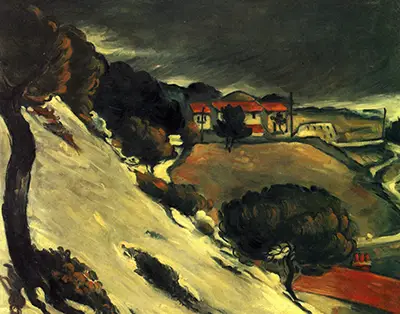Paul Cézanne's long career was marked by diversity and experimentation, as the artist moved from one style of work to another. Among all his works, L'Estaque, Melting Snow stands out. It was one of just two paintings ever produced by the artist that depict snow as part of a winter scene.
Furthermore, it was completed in a single session. In his later years, Cézanne became known for works that took him a long time to produce, with numerous sessions. The painting takes as its subject matter a country scene, which might in other moments be seen as idyllic. The red-roofed houses appear to form part of a rural village, with trees on the left and fields in the distance. However, the mood of the painting is gloomy and forboding. The sky is dark grey, suggesting that a storm is coming, and the snowbank on the left appears to be on the verge of an avalanche, which threatens the pleasant existence of the village.
L'Estaque, Melting Snow was painted in 1871, when Cézanne was dealing with some personal difficulties. The previous year, he had moved to Provence as a deliberate means of avoiding being called up for military service in the ongoing Franco-Prussian War. He hid out on his family estate and then, growing worried that he would be found, he fled to L'Estaque, a small industrial village, where he was inspired to produce this work. In January 1871, he was declared to be a draft dodger. However, the war ended a month later, before he could face the consequences of his actions.
The turbulence of the painting suggests that it could be a response to the war, as the village appears to be under threat from forces from the outside. As well as the leaden sky - picked out in monotonous, dark tones - the painting shows the trees with twisted trunks and jagged roots, helping to add to the brooding, ominous mood. Even the white of the snow is tinged with grey, suggesting that it is dirty and old, rather than freshly-fallen. Snow, often used to symbolise purity in paintings, here seems like something darker and altogether more dangerous.
This emotionally-charged painting came at a time when Cézanne's themes were changing, and he was focusing more and more on landscapes. This work shows clear Impressionist tendencies, and is often seen as similar to the paintings produced a decade later by Vincent van Gogh. Today, this painting is held by a private collector, and cannot be seen by the general public.




